Outdoor advertising offers a wealth of opportunity for innovation, inspiration and the use of nature itself to create an effective promotion. Billboards in particular offer lots of space and options to promote companies, products, and services in eye-catching ways. From using witticisms, environmental initiatives and actual products, there are tons of options to convey your advertising message.
Here are five examples of great outdoor advertising and the stories behind each.
Sioo:x Wood Protection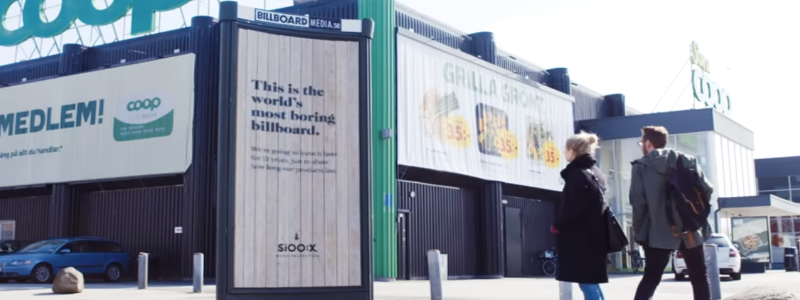
The text reads, “This is the world’s most boring billboard. We’re going to leave it here for 12 years, just to show how long our products last.”
Sioo:x Wood Protection and advertising agency Stendahls created this disarmingly simple yet effective example of outdoor advertising. Sioo:x creates a 100% environmentally friendly product that protects outdoor wood surfaces and provides a natural silvery-grey finish. The major claim to fame? The product lasts for twelve years. This inspired the design of the billboard, which is made from real Sioo:x-treated wood. The triple-sided billboard is booked for a whopping twelve years to prove the ability of the product to withstand the elements in Sweden!
Engineering for Life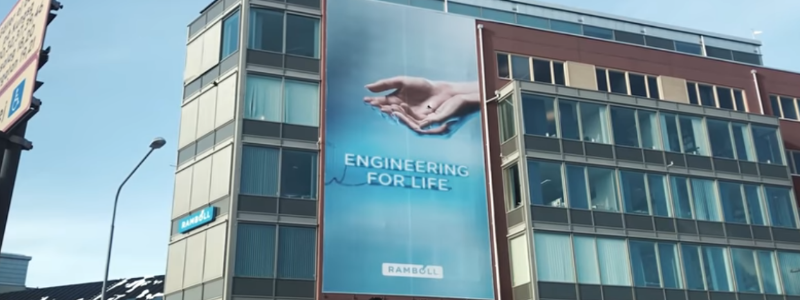
Engineering and planning firm Ramboll is responsible for this clever outdoor billboard. At first glance, it looks like a fairly straightforward advertisement on the side of an office building, but is really an environmental feat! The cupped hands on the billboard from Garbergs advertising agency are cupped to hold birds, which frequently land here. In the winter, scarce resources for local birds in Sweden means the population dwindles — but not if Ramboll has something to say about it! The cupped hands conceal a clever birdseed dispenser, which means birds that land here are guaranteed a meal.
We can’t imagine a better way for Ramboll to demonstrate their commitment to the environment!
The Dream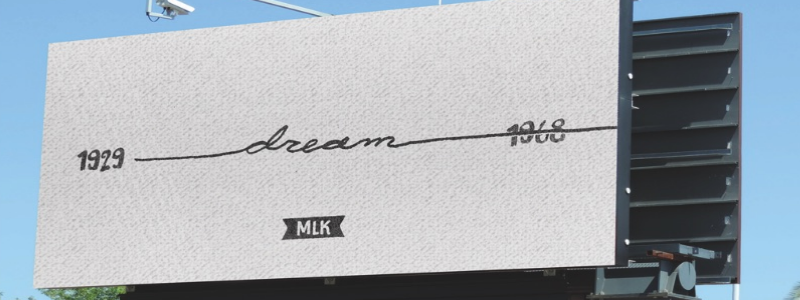
This meaningful example of outdoor advertising in Atlanta is designed to pay homage to Martin Luther King, JR. Specifically, the messaging behind the simple but impactful billboard is a celebration of his life and the dream that inspired a nation.
The dream began with his birth in 1929, and lives on today, even past his death in 1968.
Handicap International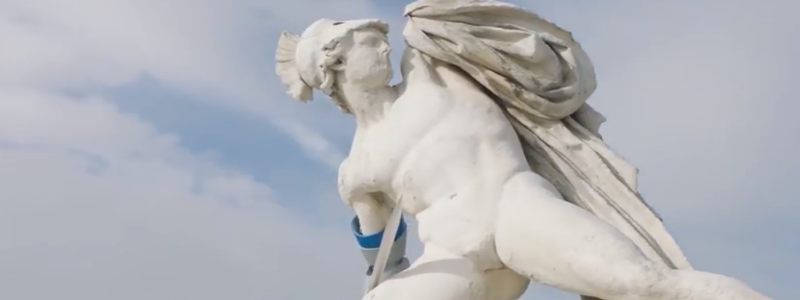
Not all great outdoor advertising strategies need to be on a billboard, as Handicap International and the Herezie group in Paris, France realized. In order to bring awareness to the long waiting lists for prosthetics, Handicap International made the daring move of outfitting the broken statues in Paris’ parks with prosthetic parts, as well as small informational signs.
The clever advertising ploy encouraged a double look for the passerby and valuable education on the issue.
Summer With Ikea
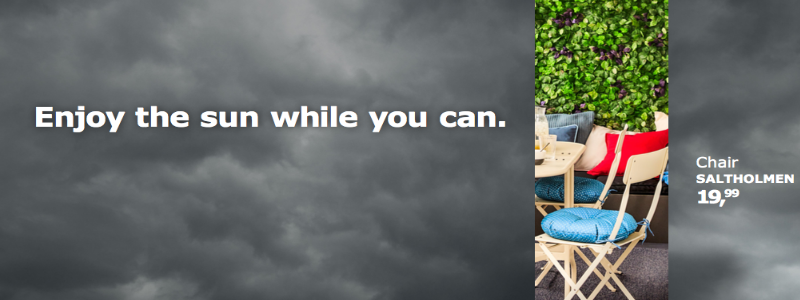
IKEA made light of the brief summer months in Belgium with a series of outdoor advertisements encouraging viewers to enjoy the brief period of summer and sunshine! The majority of the billboards are dark, stormy skies with a sliver of sunny skies and summery furniture arrangements from the retailer.
IKEA uses a clever play on humor and making fun of Belgian weather to make an impact.
Postmates Outdoor Advertisements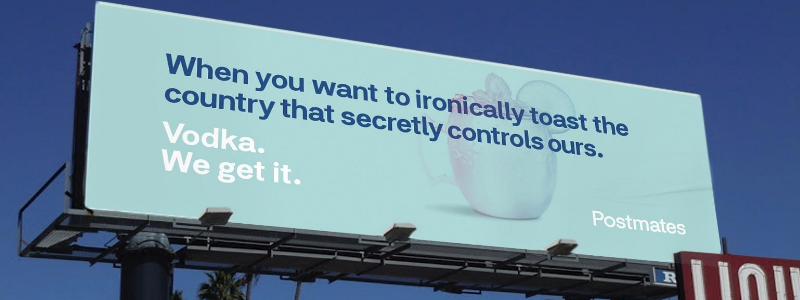
This saucy advertisement created by 180LA agency in Los Angeles is a great example of using a stop-and-stare! the tactic in outdoor advertising. Postmates delivery service superimposes wry text over a faint picture of a Moscow Mule and ties it to having vodka delivered to you.
A nod to the political drama of Russian interference in the 2016 election may take a moment for readers to process, but the resulting giggle and shock value will make readers consider Postmates twice.
Interested in more creative outdoor media examples? Check out our other article on some of our favorite Outdoor Advertising Ideas.
Historical Perspective of Great Outdoor Advertising
Outdoor advertising, often synonymous with billboards, has a history that traces back further than one might initially think. Its roots can be found in ancient civilizations, including Egypt, where large stone obelisks were used to proclaim laws and treaties. These were, in essence, the first billboards, aiming to disseminate messages to a broad audience.
In ancient Rome, walls were frequently used to post public messages, which ranged from political campaigns to popular events. Moving into the Middle Ages, signage took a turn toward the commercial, with tradesmen using signs to showcase their wares or services, especially in bustling market towns.
However, the true boom in outdoor advertising as we know it began in the 19th century. The Industrial Revolution brought about rapid urbanization and the rise of consumer goods. As products were mass-produced, the need to advertise and differentiate them became paramount. This period saw the rise of large posters and painted signs, advertising everything from medicines to shows.
The 20th century brought technological innovations that transformed outdoor advertising. The invention of the neon light in the 1910s added a luminous glow to outdoor promotions, especially in vibrant urban areas like Times Square in New York City or the Las Vegas Strip. With the advent of the automobile, roadside billboards grew in popularity, targeting travelers and commuters.
Today’s outdoor advertising world is a culmination of these historical developments, blending traditional billboard designs with high-tech digital screens, interactive features, and a focus on integration with online and social media campaigns.
Through the ages, the essence of outdoor advertising has remained consistent: to capture attention in the public sphere and convey a message effectively. As we delve deeper into other sections of this article, we’ll see how brands are innovating within this age-old medium to stay relevant in our fast-paced, digital era.
Digital Integration in Outdoor Advertising
In today’s fast-paced, interconnected world, outdoor advertising isn’t just about static images on large canvases alongside highways. With advancements in technology, the lines between digital and physical mediums are blurring, giving rise to a more interactive and dynamic form of outdoor promotion.
- Digital Billboards: No longer limited to fixed images, digital billboards can rotate through multiple ads, adjust content based on the time of day, and even display real-time data. For instance, a restaurant might showcase its breakfast menu in the morning and switch to dinner specials in the evening.
- Interactive Elements: QR codes, previously thought to be a dying technology, have seen a resurgence, especially in the post-pandemic world. They’re now frequently incorporated into outdoor ads, allowing viewers to scan and access more information, promotions, or even augmented reality (AR) experiences directly on their smartphones.
- Augmented Reality (AR) Enhancements: Brands are using AR to turn static billboards into immersive experiences. By scanning a code or using a specific app, viewers can see animated graphics, 3D models, or additional layers of information superimposed over the real-world image of the billboard.
- Data-Driven Personalization: Some billboards equipped with cameras and sensors can now adjust their displayed content based on the demographics of the passerby, such as age or gender. While this raises privacy concerns, it’s an example of how outdoor advertising is trying to be as targeted and personalized as its online counterpart.
- Social Media Integration: Many outdoor campaigns now come with hashtags, encouraging viewers to share their experiences or thoughts on social platforms. This not only boosts the ad’s reach but also helps brands engage with their audience in a two-way conversation.
- Real-time Updates: Some campaigns utilize real-time data to keep their content fresh and relevant. For instance, a travel company might display the current temperature in a popular holiday destination, or a sports brand could showcase live scores during a big game.
- Environmental Sensors: Billboards in certain locations come equipped with environmental sensors. Depending on factors like rain, sunlight, or temperature, the content of the advertisement might change. For example, an ad for a clothing brand could showcase raincoats during wet conditions and sunglasses on sunny days.
How To Promote Your Product & BMedia Group Puerto Rico
Promoting your product and effectively expanding your client base requires a multi-faceted approach that aligns with your target audience’s preferences and behaviors. In Puerto Rico’s dynamic market, embracing billboard advertising as part of your promotional strategy can yield remarkable results. By strategically positioning your product in high-traffic areas, crafting compelling visuals and messages, and tapping into the cultural nuances of the island, you can create a memorable and impactful campaign that resonates with your audience.


 787 792 4113
787 792 4113

Leave a Reply
Want to join the discussion?Feel free to contribute!